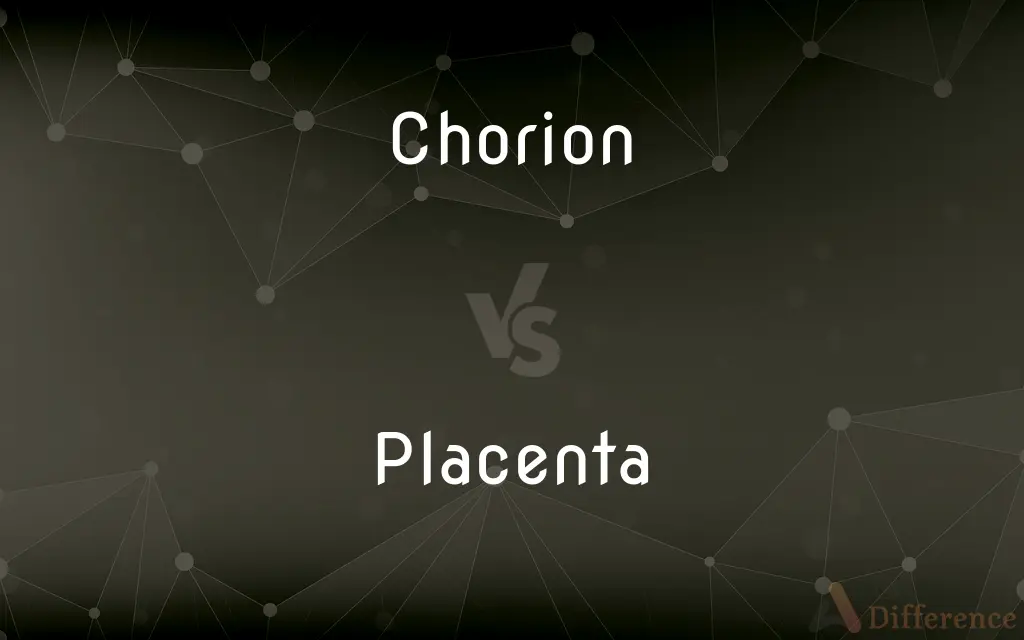Chorion vs. Placenta — What's the Difference?
Edited by Tayyaba Rehman — By Maham Liaqat — Updated on April 17, 2024
The chorion is an outer fetal membrane in mammals that contributes to the placenta formation, whereas the placenta is a complex organ directly supporting fetal development by facilitating nutrient and waste exchange.

Difference Between Chorion and Placenta
Table of Contents
ADVERTISEMENT
Key Differences
The chorion is one of the outermost layers of the fetal membranes, playing a crucial role in the early stages of fetal development. It surrounds the embryo and other membranes. In contrast, the placenta is a unique organ formed by the combination of fetal tissues, primarily the chorion, and maternal tissues. It develops fully in the uterus wall.
The chorion participates in the formation of the placenta by developing finger-like projections called chorionic villi. These villi penetrate the uterine lining to facilitate nutrient and oxygen transfer from the mother to the fetus. Meanwhile, the placenta, through these villi, establishes a physical and biochemical connection between the mother and fetus, crucial for nutrient uptake, waste elimination, and gas exchange.
Initially, the chorion helps to protect the embryo and is involved in hormone production, such as human chorionic gonadotropin (hCG), which is essential for maintaining pregnancy. On the other hand, the placenta takes over these roles as it matures, becoming the primary site for hormone production and regulation, including hCG, progesterone, and estrogen.
The chorion starts to form almost immediately after implantation and is essential for the early attachment of the embryo to the maternal endometrium. In contrast, the development of the placenta begins around the third month of pregnancy and continues to grow and adapt throughout gestation.
While the chorion is primarily a protective and endocrine supportive layer in early pregnancy, the placenta evolves to become the central organ for fetal-maternal exchange, adapting to the needs of the growing fetus throughout the pregnancy.
ADVERTISEMENT
Comparison Chart
Definition
The outermost fetal membrane that contributes to placenta formation.
An organ attached to the lining of the womb, facilitating nutrient and waste exchange between mother and fetus.
Function
Protects the fetus and produces hormones like hCG.
Exchanges nutrients, gases, and wastes between mother and fetus; produces hormones.
Development
Forms shortly after implantation.
Develops from the chorion and maternal tissues, becomes fully functional by the end of the first trimester.
Structure
Thin layer of tissue with chorionic villi.
Thick, vascular organ that includes maternal and fetal tissues.
Role in Pregnancy
Initial attachment to the endometrium; hormone production.
Central organ for maternal-fetal exchange; major endocrine functions.
Compare with Definitions
Chorion
The chorion secretes hormones essential for maintaining pregnancy.
The hormone hCG, secreted by the chorion, is detected in pregnancy tests.
Placenta
It grows throughout pregnancy and adapts to the needs of the fetus.
The placenta changes its capacity and function as the fetus grows.
Chorion
The chorion is the outermost fetal membrane in mammals, including humans.
The chorion forms part of the placenta and contributes to fetal development.
Placenta
The placenta is an organ that connects the developing fetus to the uterine wall to allow nutrient uptake.
The placenta is critical for transferring oxygen from the mother to the fetus.
Chorion
The chorion becomes less distinct as the placenta develops.
As the pregnancy progresses, the chorion's role is overtaken by the developing placenta.
Placenta
The placenta produces hormones that regulate fetal growth and maintain the pregnancy.
Apart from hCG, the placenta also secretes progesterone.
Chorion
It plays a protective role and contributes to the embryo's implantation in the uterus.
The chorion's development is crucial for the pregnancy to proceed.
Placenta
The placenta is expelled from the uterus after childbirth.
The delivery of the placenta is the final stage of labor.
Chorion
It develops chorionic villi that help attach the fetus to the maternal endometrium.
The chorionic villi increase in number and complexity during early pregnancy.
Placenta
The placenta is a temporary fetal organ that begins developing from the blastocyst shortly after implantation. It plays critical roles in facilitating nutrient, gas and waste exchange between the physically separate maternal and fetal circulations, and is an important endocrine organ producing hormones that regulate both maternal and fetal physiology during pregnancy.
Chorion
The chorion is the outermost fetal membrane around the embryo in mammals, birds and reptiles (amniotes). It develops from an outer fold on the surface of the yolk sac, which lies outside the zona pellucida (in mammals), known as the vitelline membrane in other animals.
Placenta
A flattened circular organ in the uterus of pregnant eutherian mammals, nourishing and maintaining the fetus through the umbilical cord.
Chorion
The outer membrane enclosing the embryo in reptiles, birds, and mammals. In placental mammals it contributes to the development of the placenta.
Placenta
(in flowers) part of the ovary wall to which the ovules are attached.
Chorion
The protective and nutritive membrane in higher vertebrates that attaches the fetus to the uterus.
Placenta
A membranous vascular organ that develops in female eutherian mammals during pregnancy, lining the uterine wall and partially enveloping the fetus, to which it is attached by the umbilical cord. Following birth, the placenta is expelled.
Chorion
The outer case of an insect egg.
Placenta
A similar organ in marsupial mammals, consisting of a yolk sac attached to the uterine wall.
Chorion
(botany) The outer membrane of seeds of plants.
Placenta
An organ with similar functions in some nonmammalian animals, such as certain sharks and reptiles.
Chorion
The outer membrane which invests the fetus in the womb; also, the similar membrane investing many ova at certain stages of development.
Placenta
(Botany) The part within the ovary of a flowering plant to which the ovules are attached.
Chorion
The outer membrane of seeds of plants.
Placenta
(anatomy) An organ in most mammals during gestation that supplies food and oxygen to the foetus and passes back waste. It is on wall of the uterus and links to the foetus through the umbilical cord. It is expelled after birth.
Chorion
Outermost membranous sac enclosing the embryo in higher vertebrates (reptiles, birds and mammals)
Placenta
(botany) In flowering plants, the part of the ovary where ovules develop; in non-flowering plants where the spores develop.
Placenta
The vascular appendage which connects the fetus with the parent, and is cast off in parturition with the afterbirth.
Placenta
The part of a pistil or fruit to which the ovules or seeds are attached.
Placenta
That part of the ovary of a flowering plant where the ovules form
Placenta
The vascular structure in the uterus of most mammals providing oxygen and nutrients for and transferring wastes from the developing fetus
Common Curiosities
How do doctors monitor the health of the placenta during pregnancy?
The health of the placenta is typically monitored through ultrasound examinations, which can assess its position, structure, and blood flow to ensure it is functioning properly.
What role does the chorion play in hormone production during pregnancy?
The chorion produces the hormone human chorionic gonadotropin (hCG), which is crucial for maintaining the corpus luteum and thus sustaining progesterone production vital for pregnancy.
How is the placenta attached to the fetus?
The placenta is attached to the fetus via the umbilical cord, which serves as the conduit for all exchanges between the mother and the fetus.
Is the structure of the placenta the same in all mammals?
While the basic functions of the placenta are similar, its structure can vary significantly among different mammalian species, affecting the specifics of nutrient and waste exchange.
How do defects in the chorion affect pregnancy?
Defects in the chorion can lead to complications such as improper implantation, which might result in pregnancy loss or placental insufficiency.
Can the chorion provide any nutrients directly to the fetus?
No, the chorion itself does not provide nutrients directly to the fetus; instead, it helps form the placenta, which then handles nutrient and gas exchange.
What happens to the chorion as pregnancy progresses?
As pregnancy progresses, the chorion's role diminishes as the placenta becomes fully functional and the chorionic villi expand to form the placental structure.
What medical conditions can affect the placenta during pregnancy?
Conditions like placenta previa, placental abruption, and placental insufficiency can affect the placenta, leading to serious pregnancy complications.
What distinguishes the placenta from other organs in the body?
Unlike other organs, the placenta is unique in that it is a temporary organ created during pregnancy, specifically for the purpose of supporting the fetus, and is expelled after birth.
How do the roles of the chorion and placenta differ in fetal protection?
The chorion primarily provides initial protection and contributes to placenta formation, while the placenta offers comprehensive protection by regulating the fetal environment and serving as a barrier to certain pathogens.
What are the long-term impacts of placental malfunctions on fetal development?
Malfunctions in the placenta can lead to restricted fetal growth, low birth weight, preterm birth, and in severe cases, stillbirth.
Share Your Discovery

Previous Comparison
Tangible vs. Intangible
Next Comparison
Gout vs. BunionAuthor Spotlight
Written by
Maham LiaqatEdited by
Tayyaba RehmanTayyaba Rehman is a distinguished writer, currently serving as a primary contributor to askdifference.com. As a researcher in semantics and etymology, Tayyaba's passion for the complexity of languages and their distinctions has found a perfect home on the platform. Tayyaba delves into the intricacies of language, distinguishing between commonly confused words and phrases, thereby providing clarity for readers worldwide.
















































